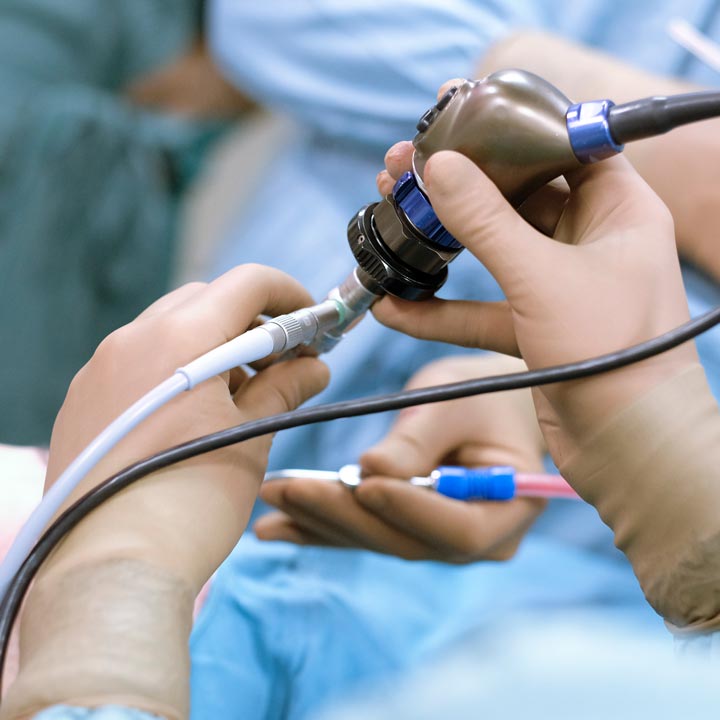
Comprehensive Esophageal Health Center opens with more convenient, streamlined care
 The recently expanded and restructured endoscopic program at The Ohio State University Wexner Medical Center ensures more people across the region can get the care they need, including novel treatments not available at other centers. There are now four endoscopy units: two are hospital-based, and two are in ambulatory surgery centers in Dublin and New Albany.
The recently expanded and restructured endoscopic program at The Ohio State University Wexner Medical Center ensures more people across the region can get the care they need, including novel treatments not available at other centers. There are now four endoscopy units: two are hospital-based, and two are in ambulatory surgery centers in Dublin and New Albany.
“We have refocused what we do for patients — to match up each person with the best facility for their endoscopic procedure based on their unique needs and location,” says Lanla Conteh, MD, MPH, MBA, clinical associate professor of Internal Medicine in the Division of Gastroenterology, Hepatology and Nutrition in the Ohio State College of Medicine. “For our higher acuity patients who require more complex endoscopic procedures, we’re able to reserve hospital space for them, and our patients undergoing routine screening procedures are able to have access to our ambulatory centers.”
This restructure has enabled all stakeholders involved in endoscopy, including gastroenterology, surgery, anesthesia, nursing and administration, to sit at the table collectively to determine what’s best for our patients.
“What distinguishes us is that it is not just gastroenterologists who are doing endoscopy. We recognize the expertise of our surgical colleagues within this space and ensure we are serving the needs of our different service lines and each patient who comes to these specialties,” Dr. Conteh says.
This helps maintain open lines of communication and allows the team to be facile in how they shift resources around the system. The collaborative structure ensures that people are placed first above anything else and have access to safe, patient-centered care in a timely manner.
As a tertiary health care center — and given the complexity of procedures we offer — Ohio State has a large referral network. For instance, 150 to 170 liver transplants are performed here each year. Within this space, the team has a lot of experience with decompensated liver disease, portal hypertension and varices. Ohio State’s liver care expertise allows the endoscopic program to provide specific procedures to treat gastric varices that aren’t being performed at other centers.
“Our two hospital-based endoscopy units have been recognized as high-quality centers by the American Society for Gastrointestinal Endoscopy [ASGE] Governing Board, receiving honoree status in the ASGE Endoscopy Unit Recognition Program through 2026,” Dr. Conteh says. “This is a distinction of the quality of care our medical center provides. It highlights the teamwork from the nursing perspective, the physician perspective and everybody coming together to put the patient first in what we do and make sure they get the best quality that anyone in the U.S. can offer.”
Across the board, Ohio State’s endoscopic enterprise is also one of the top performers for adenoma detection rates, one of the quality metrics with screening colonoscopies. And as part of the commitment to deliver equitable care, we provide free colonoscopies for uninsured or underinsured patients within the Columbus area a few times a year, a program that’s been offered for the past several years.
“The physicians in advanced endoscopy at the Ohio State Wexner Medical Center are experts at performing complex pancreatic cyst procedures. We are able to avoid unnecessary surgical intervention for many patients,” Dr. Conteh says.
As a leader in the field of endoscopic ultrasound and management of pancreatic cysts, Ohio State is advancing diagnostic procedures to accurately identify precancerous pancreatic cysts. Pancreatic cysts are common, and the majority are found incidentally on imaging studies. It can be difficult to distinguish between benign cysts and those that may become cancerous.
Somashekar Krishna, MD, MPH, is a gastroenterologist and lead researcher pioneering an endoscopic procedure that emits a laser beam inside the pancreatic cyst, providing doctors with a microscopic view of the cyst wall. This allows them to determine with confidence — and in real time — if it’s precancerous or benign.
Pancreatic cancer is the third deadliest cancer in the United States, leading to more than 50,000 deaths each year. Symptoms don’t appear until advanced stages, making treatment a challenge. Early detection and accurate diagnosis are necessary to improve patient outcomes.
Ohio State is poised to be the first in central Ohio to offer an endobariatrics program. Comprising a collaborative, multidisciplinary team approach with gastroenterologists, surgeons and nutritionists, it will offer patients an alternative weight loss solution.
With a 42% prevalence rate in the United States, the obesity epidemic has become a public health crisis that only continues to grow. This serious chronic condition can lead to a host of medical issues, including cardiovascular disease, diabetes, gallbladder disease and cancer. The traditional weight loss management continuum spans from lifestyle changes and medications to bariatric surgery, along with combinations of comprehensive approaches. Some patients may be reluctant to undergo surgery, while others may not be good surgical candidates.
“Endobariatrics is a less invasive approach compared to traditional bariatric surgery, and is associated with fewer side effects,” Dr. Conteh says. “It also allows us to provide weight loss intervention for people who may otherwise not qualify for traditional bariatric surgery.”
As an emerging field, endobariatrics holds great promise in helping to address the obesity epidemic. And it’s one more way Ohio State is leading the charge to help people and improve public health outcomes.